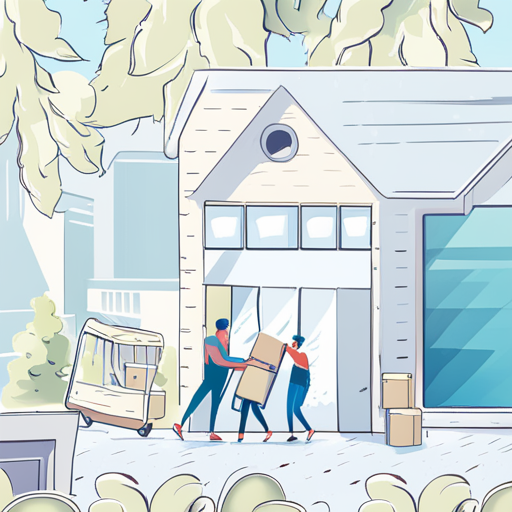How Do I Declutter Before Moving?
Moving into a smaller space can be a great opportunity to declutter. Here’s a step-by-step guide:
- Sort Your Items: Divide your belongings into three categories: keep, donate, and discard.
- Use the 6-Month Rule: If you haven’t used something in the past six months, consider getting rid of it.
- Sell Unwanted Items: Use platforms like eBay, Facebook Marketplace, or local classifieds to sell items you no longer need.
- Donate: Consider donating items to local charities or thrift stores.

What Should I Consider When Downsizing Furniture?
When moving to a smaller space, choosing the right furniture is crucial. Here’s what to consider:
- Measure Your New Space: Know the dimensions of your new home to ensure your furniture fits.
- Opt for Multifunctional Pieces: Furniture that serves multiple purposes, like a sofa bed or a coffee table with storage, is ideal.
- Prioritize Essentials: Focus on the furniture you need most and can use daily.
How Can I Maximize Storage in a Small Space?
Maximizing storage is key in smaller homes. Here are some effective strategies:
- Vertical Storage: Use shelves and wall-mounted units to save floor space.
- Under-Furniture Storage: Utilize space under beds and sofas for storage bins and boxes.
- Custom Solutions: Invest in custom-built storage solutions like fitted wardrobes and kitchen organizers.
What Are Some Tips for Organizing a Small Home?
Organizing a small home requires creativity and planning. Here are some tips:
- Use Clear Containers: Transparent containers help you easily see what’s inside.
- Label Everything: Labeling helps keep everything in its place and makes finding items easier.
- Regularly Purge: Regularly go through your items and remove things you no longer need.
How Much Does It Cost to Move into a Smaller Space?
Moving costs can vary based on several factors. Here’s a rough estimate:
| Service | Estimated Cost |
|---|---|
| Moving Company | €300 – €1,500 |
| Storage Units (per month) | €50 – €200 |
| Packing Supplies | €50 – €150 |
| Cleaning Services | €100 – €300 |
Are There Any Financial Benefits to Downsizing?
Downsizing can offer several financial benefits:
- Lower Mortgage or Rent: Smaller homes typically have lower monthly payments.
- Reduced Utility Bills: Less space means lower heating, cooling, and electricity costs.
- Less Maintenance: Smaller homes generally require less upkeep and repair costs.
What Should I Do First After Moving In?
After moving into your new smaller space, follow these steps:
- Unpack Essentials First: Start with the items you use daily, like kitchenware, toiletries, and clothing.
- Set Up Key Areas: Focus on setting up the kitchen, bedroom, and bathroom first.
- Take Your Time: Don’t rush the process. Give yourself time to organize and adjust to your new space.
How Can I Make a Small Space Feel Bigger?
Moving into a smaller space doesn’t mean you have to compromise on style or comfort. Here are some detailed tips on making your small space feel bigger, including furniture types, styles, and examples.
Use Light Colors
Why Light Colors?
Light colors reflect more light, making a room feel airy and open. They can create an illusion of space, which is crucial in smaller homes.
Best Light Colors
- White: Classic and clean, white walls and furniture make any room look larger.
- Pastels: Soft shades like pale blue, mint green, and blush pink add a touch of color without overwhelming the space.
- Neutral Tones: Beige, light gray, and soft taupe can make a space feel warm and inviting while still appearing spacious.
Example
Imagine a small living room with white walls, light gray furniture, and pastel accents. The light colors create a serene and expansive feel, making the room appear larger than it is.
Incorporate Mirrors
Why Mirrors?
Mirrors reflect both natural and artificial light, which can make a room feel brighter and more spacious. They also create a sense of depth.
How to Use Mirrors
- Large Wall Mirrors: Placing a large mirror on a main wall can significantly enhance the feeling of space.
- Mirrored Furniture: Furniture pieces like mirrored coffee tables or cabinets can add both style and the illusion of more room.
- Cluster of Small Mirrors: A collection of small mirrors arranged artistically can serve as both decor and a space enhancer.
Example
A dining area with a large mirror on one wall, combined with a glass dining table, can make the space look bigger and more open.
Choose Open Furniture
Why Open Furniture?
Furniture with exposed legs or open shelving allows you to see more of the floor space, creating a sense of openness.
Types of Open Furniture
- Sofas with Legs: A sofa with exposed legs allows light to pass under, making the room feel less cramped.
- Open Shelving Units: Instead of bulky cabinets, use open shelves to store and display items. This avoids blocking sightlines.
- Glass or Lucite Tables: Transparent tables reduce visual clutter and help maintain an airy feel.
Example
A living room featuring a sofa with wooden legs, open shelving, and a glass coffee table will appear more spacious and less crowded.

Optimize Furniture Layout
Why Layout Matters?
The way you arrange your furniture can have a big impact on how spacious a room feels. Proper layout can create better flow and make a small space more functional.
Tips for Layout
- Floating Furniture: Don’t push all furniture against the walls. Floating furniture can create pathways and make the room feel larger.
- Functional Zones: Create specific areas for different activities (e.g., reading nook, work area) to make the space more organized.
- Diagonal Arrangement: Placing furniture at an angle can break up the boxy feel of a small room and add visual interest.
Example
A small studio apartment where the sofa is placed at an angle in the center, creating a distinct living area separate from the sleeping space, can make the room feel larger and more purposeful.
Utilize Multi-Functional Furniture
Why Multi-Functional Furniture?
In small spaces, every piece of furniture should serve more than one purpose to maximize utility without overcrowding.
Examples of Multi-Functional Furniture
- Sofa Beds: Perfect for studios or one-bedroom apartments, they offer seating by day and a bed by night.
- Ottomans with Storage: Great for living rooms, they can be used for seating, as a coffee table, and for hidden storage.
- Foldable or Extendable Tables: These can be compact when not in use but expanded when you need more surface area.
Example
A small bedroom featuring a bed with built-in drawers underneath and a foldable desk that can be stowed away when not in use, helps keep the room uncluttered and functional.
Use Vertical Space
Why Vertical Space?
Utilizing vertical space helps keep the floor area clear and makes the room feel less cluttered.
How to Use Vertical Space
- Tall Shelves and Bookcases: These draw the eye upward, emphasizing the height of the room.
- Wall-Mounted Cabinets: They provide storage without taking up floor space.
- Hanging Plants and Decor: These can add character and greenery without encroaching on living space.
Example
A small kitchen with tall cabinets that reach the ceiling, providing ample storage and making the room feel taller and more spacious.

Conclusion
Making a small space feel bigger is all about smart design choices. By using light colors, incorporating mirrors, choosing open and multi-functional furniture, optimizing your layout, and utilizing vertical space, you can create a home that feels both comfortable and spacious.
Dublin Removals is here to help you transition smoothly into your new, well-organized small space.
